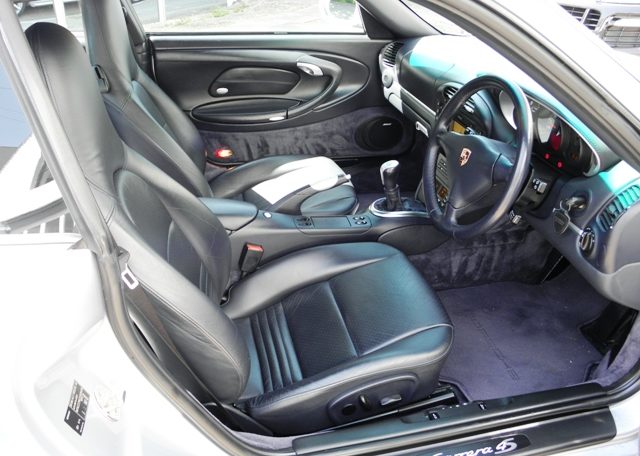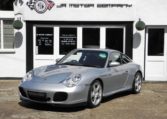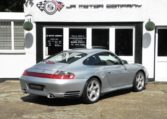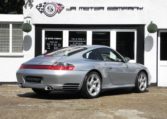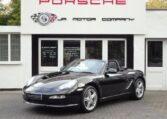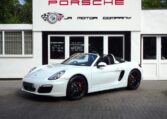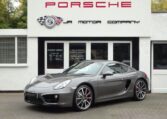PORSCHE 911 (996) 3.6 CARRERA 4S X51
Extremely rare C4S complete with a huge spec and the X51 Power kit together with a Sports exhaust! This is probably the only C4S with the X51 available in the UK.£29,995
SoldPorsche 911 996 Carerra 4S X51 Manual Widebody Coupe finished in Polar Silver Metallic paint.
Absolutely stunning and extremely special 911 996 Carrera 4S X51 Manual 6 speed finished in Polar Silver metallic paint and complete with a huge list of factory fitted options which includes X51 Carrera Powerkit together with XLF Porsche Sports Exhaust system with polished tailpipes,full Metropole dark blue extended smooth natural leather interior trim including dashboard and door panels,electric adjustable memory seats,smooth leather 3 spoke sports leather steering wheel,alcantara roof lining,alluminium gearshift and handbrake with Porsche crest,alluminium dash surround,center vents and center dash strip,black dials,cruise control,(PCM2) Porsche communications management sat nav with cd player linked with Bose sound package,CDC4 multichanger and cd storage,(PSM) Porsche Stability management,18 inch turbo alloy wheels wrapped in n rated Michelin tyres with new 4s centers,litronic headlights with wash,windscreen with green shade band,red brake calipers,Porsche overmats,rear wiper,climate air conditioning to complete a very special 911.This stunning C4S comes complete with a fully documented immaculate OPC Porsche plus Porsche specialist service record totalling 13 stamps just completed by ourselves with a recent clutch kit and uprated IMS bearing and seals together with all spare keys and handbook pack.An outstanding appreciating 911 which is probably the only X51 available making this a solid investment! For those unfamiliar with the X51 option : Unlike the turbos, it was quite a bit more than just a remap/power upgrade for an extra cost new of around six thousand pounds, X51 option included: new intake manifold with modified cross-section (material: sand cast aluminum ) new intake pipe supports adapted to the form of the intake manifold new exhaust manifolds with larger cross-section and optimized flow behavior new cylinder heads with optimized, CNC-milled inlet ducts new camshafts with larger valve stroke on the inlet side and modified inlet and outlet timing inlet valve springs adapted to the enlarged valve stroke modified partition box in the oil pan modified maps for the DME control module. Although the overall power increase equated to just 25hp more over standard, it was supposedly “toned down” so as not to compete with its big brother the GT3 which produced 381hp. Together with the XLF Porsche Sports exhaust system this makes for a very rare and special collectable C4S.
For those unfamiliar with the X51 option :
Unlike the turbos, it was quite a bit more than just a remap/power upgrade for an extra cost new of around six thousand pounds, X51 option included:
new intake manifold with modified cross-section (material: sand cast aluminum )
new intake pipe supports adapted to the form of the intake manifold
new exhaust manifolds with larger cross-section and optimized flow behavior
new cylinder heads with optimized, CNC-milled inlet ducts
new camshafts with larger valve stroke on the inlet side and modified inlet and outlet timing
inlet valve springs adapted to the enlarged valve stroke
modified partition box in the oil pan
modified maps for the DME control module.
Although the overall power increase equated to just 25hp more over standard, it was supposedly “toned down” so as not to compete with its big brother the GT3 which produced 381hp.
Together with the XLF Porsche Sports exhaust system this makes for a very rare and special collectable C4S.
Contact us anytime to arrange a viewing.
- (PSE) Porsche Switchable Sports Exhaust System
- (PSM) Porsche Stability Management
- 3 Spoke Leather Steering Wheel
- Air Conditioning
- BOSE® Surround Sound
- Climate Controlled Air Conditioning
- Extended Leather
- Full Metropole Blue smooth leather interior
- PCM 2 Porsche Communications Management
Porsche 911 Carrera 4S (996) Review
The 911 Carrera 4S looks very similar to the 911 Turbo, as the front end has the same dark-finish air intake openings as the top model. A slight difference is visible at the spoiler lip, which is slightly raised in the center, thereby documenting the new, carefully controlled aerodynamic balance.
The rear section of the body is 60 mm wider than on the Carrera models based on the 996 model series – and in the wheel housings the standard 18-inch alloy wheels in Turbo styling provide ample traction. Another subtle difference between this model and the Turbo becomes obvious at the rear: A Carrera spoiler is used instead of the extending divided wing, and includes a red light strip providing a visual link between the two rear lights. These detail modifications give the Carrera 4S a distinctly different, striking rear-end appearance.
Four-wheel traction This model has a 320 bhp 3.6-litre flat-six power unit and standard four-wheel drive. With this technology and the viscous multiple-plate clutch, the front wheels deliver a constant minimum of 5 per cent of the tractive force to the road, rising to as much as 40 per cent if more is needed. The “Porsche Stability Management” (PSM) electronic dynamic driving control system, which, in conjunction with four-wheel drive, makes this a particularly safe car, is also standard equipment.
Top Porsche quality for suspension and brakes The suspension of the 911 Carrera 4S has been lowered by 10 millimetres and is based on the 911 Turbo; including the brake system, the engine mounts and a front-axle pivot bearing optimised for good brake ventilation. This layout provides a unique combination of sport-style road behaviour, supreme handling and extremely high road safety. The wider rear track and the 295/30 ZR 18 rear tyres also increase the dynamic driving potential.
The brake system adopted from the 911 Turbo is another top-level active safety feature. Compared with the Carrera models, the front and rear wheels are decelerated by larger, uprated four-piston fixed callipers and the cross-drilled, inner vented brake discs are larger in size. These measures ensure extreme braking power in even the toughest conditions such as motor racing.
Like the 911 Turbo, the Carrera 4S is available as an option with “Porsche Ceramic Composite Brakes” or “PCCB” for short, reducing weight by approximately 50 per cent versus conventional brakes with grey-cast-iron discs. Further advantages in general traffic are a long running life and absolute resistance to any corrosion.
Top-quality standard equipment Standard equipment of the Carrera 4S includes automatic air conditioning, heat-insulating glass, electric window lifts, electrically adjustable and heated rear-view mirrors, central locking, an electronic immobiliser, an alarm system with interior surveillance, and an on-board computer.
Over and above the features also coming as standard on the 911 Carrera Cabriolet, the Carrera 4S has a metallic paintwork, an abundance of leather in the interior, an audio sound package and electrically adjustable seats with a memory function for the driver’s side. The seat memory can be activated via buttons on the door sill or with the remote-control ignition key.
Porsche 911 Carrera 4S - Carrera in Turbo-Look The Carrera 4S leaves no doubt as to what inspired its design: the 911 Turbo. The rear fenders of the Carrera 4S increase its width by 60 millimetres compared with the 996 model series 911 Carrera, creating ample space for the standard 18-inch alloy wheels in Turbo design with 295/30 ZR 18 tyres. The Turbo model’s typical air intakes in the broad fenders, however, are lacking. These large side openings are not needed, as the engine compartment has no charge-air intercoolers demanding an abundant supply of fresh air. This, along with other aerodynamic measures, results in the improved aerodynamic drag coefficient of Cd = 0.30.
The engine cover on the 911 Carrera 4S has been matched to the wider rear end and is made of glass-fibre reinforced plastic. This material is frequently used in Porsche’s motorsport activities and gives the designers and development engineers more freedom at the design stage. At the lower edge of the rear flap is a red light strip providing a visual link between the two rear lights. Another distinguishing Carrera 4S feature is the rear spoiler, adopted from the 911 Carrera, which extends automatically at 120 km/h for safe road behaviour at high speeds. Like the rear cover, the front end with its three characteristic dark-trimmed air intake openings has been taken over from the 911 Turbo, but modified slightly: Raising the spoiler lip in the centre adjusts front axle lift so that optimum aerodynamic balance between axle lift forces is obtained.
Top speed: 174 mph With its 3.6-litre, 320 bhp flat-six power unit, the Carrera S accelerates from a standstill to 60 mph in 5.1 seconds and has a top speed of 174 mph. And despite this vast power output and the high, flat torque curve, fuel consumption according to the EU standard test method is 11.4 litres per 100 kilometres, an improvement of more than 7 per cent compared with the previous 993-series model with its 285 bhp engine at the rear.
This significant reduction in fuel consumption from the six-cylinder engine is mainly due to VarioCam Plus, which Porsche developed initially for the 911 Turbo, but which is now, with suitable settings, also used on naturally-aspirated engines in other 911 models. This system, which adds a valve lift changeover device on the inlet side to the VarioCam variable inlet camshaft system, consists of movable cup tappets actuated by an electrohydraulic 3/2-way valve. Different cam profiles are provided on the inlet camshaft and brought into action with the corresponding valve lift values by repositioning the tappets. One might therefore say that VarioCam Plus makes two engines out of one: the first has low valve lift and is ideal for city traffic and part-loads. The second engine, with greater valve lift, supplies three times as much torque within fractions of a second and is designed for top performance.
The 3.6-liter flat-six engine has four oxygen sensors in the exhaust system – one control and one diagnostic sensor for each cylinder bank. Together with secondary air injection, modern catalytic converter technology using metal monoliths enables the 911 Carrera 4S to comply easily with exhaust emission limits worldwide.
Safe, reliable traction The Carrera 4S has four-wheel drive as a standard in both the six-speed manual-gearbox and Tiptronic S versions. With four-wheel drive including a multiple-plate viscous coupling clutch in the driveline, the front wheels apply a constant minimum of 5 per cent of the total traction force to the road, but up to 40 per cent if more is needed. Rather than ultimate traction, the emphasis is on supreme behaviour and safety. In conjunction with four-wheel drive, the “Porsche Stability Management” (PSM) electronic dynamic driving control system makes driving particularly safe and is also standard equipment.
PSM for extra driving safety The combination of four-wheel drive designed consistently for dynamic motoring and electronic “Porsche Stability Management” (PSM) matched specifically to this drive concept offers not only a particularly high standard of driving safety, but also the joy of motoring so typical of Porsche.
This is precisely what Porsche engineers are able to guarantee, using control and management features not to be found in other cars even with similar systems. As a result, a Porsche retains its agile, sporting and dynamic behaviour all the way to the ultimate limit. And thanks to the high safety reserves of Porsche’s suspension, the system is only required to intervene in the car’s steering behaviour on a dry road when the driver chooses an extreme style of motoring, as is typically the case in racing. “PSM” therefore discreetly and almost unnoticeably corrects any minor deviations from directional stability resulting from a change in loads or partial application of the brakes in a bend. And at the same time Porsche’s engineers allow “PSM” to intervene at an earlier point and more energetically on a wet or slippery surface and, in particular, on constantly varying, different road surfaces.
In its operation, “PSM” follows two fundamental control strategies: First, Porsche’s well-known longitudinal dynamics control using the anti-lock brake system, anti-slip control and the automatic brake differential for smooth acceleration and application of the brakes on a straight line and in bends, with the car remaining stable and exactly on course. Second, “PSM” offers lateral dynamics control to keep the car stable even under high lateral forces in a bend. The corrective action required for this purpose is provided by activating the individual brakes of the car, as required. Any tendency of the car to oversteer, for example, with the rear end swerving round, is counteracted by careful application of the brakes on the outer front wheel. Understeering, in turn, is prevented by applying the brakes on the inner rear wheel in a bend.
The car’s longitudinal dynamics control may also intervene here when required, E-gas serving to change the modified position of the throttle butterfly according to specific requirements. To ensure optimum precision at all times, “PSM” uses a number of sensors and control functions. The wheel speed sensors incorporated in the ABS brake system, for example, not only provide information on the car’s road speed, acceleration and deceleration, but are also able, taking differences in wheel speed into account (left/right), to recognise bends and their radius. Further control functions are performed by a steering angle sensor, a lateral accelerometer, and a yaw angle sensor determining any tendency of the car to drift. All data registered by the sensors is stored in the “PSM” computer, then being evaluated within fractions of a second and converted into commands transmitted to the E-gas or brake control system. As a result, “PSM” responds far more quickly to threatening situations than even a routined driver.
The driver wishing to really experience the car’s “natural" lateral dynamics on the race track has the option to temporarily deactivate “Porsche Stability Management” (PSM) by means of a switch in the instrument panel. But even then, the driver need not run an unlimited risk: Whenever the car’s drift angle becomes excessive, all the driver has to do is put his foot on the brake pedal in order to reactivate “PSM”. Which means that in principle the system pushes the limits of physics a bit further to the extreme, without – obviously – being able to override these limits.
Same brake system as on the Turbo – and as an option with PCCB With its Turbo brake system, the 911 Carrera 4S offers absolutely excellent braking performance. The cross-drilled, inner-vented brake discs measure 330 millimetres or 13.00" in diameter and 34 millimetres or 1.34" in width at the front. The rear brake discs have the same diameter and are 28 millimetres or 1.10" wide. This system guarantees extreme braking power even in the toughest conditions such as motor racing.
As an option the Carrera 4S is available with “Porsche Ceramic Composite Brakes” (PCCB) approximately 50 per cent lighter than conventional brakes with grey-cast-iron brake discs and reducing unsprung masses accordingly. Further advantages of “PCCB” brakes are their long running life in public transport and their absolute resistance to corrosion.
Standard equipment far superior to Carrera models As far as equipment is concerned, Porsche leaves the exclusive position of the Carrera 4S in no doubt, placing it very close to the 911 Turbo. This means standard equipment including not only automatic air conditioning, heat-insulating glass, electric window lifts, electrically adjustable and heated rear-view mirrors, central locking, an electronic immobiliser, an alarm system complete with interior surveillance, and an on-board computer, but also other features and signs of distinction. Then, of course, there is four-wheel drive and “Porsche Stability Management” (PSM), special 18-inch wheels in Turbo design and 295/30 ZR 18 rear tyres, a brake system increased in size, red brake callipers, metallic paintwork, an audio system with sound package, electrically adjustable seats with a position memory function and all leather upholstery and trim.
A selection of our Porsche models currently available for sale.















